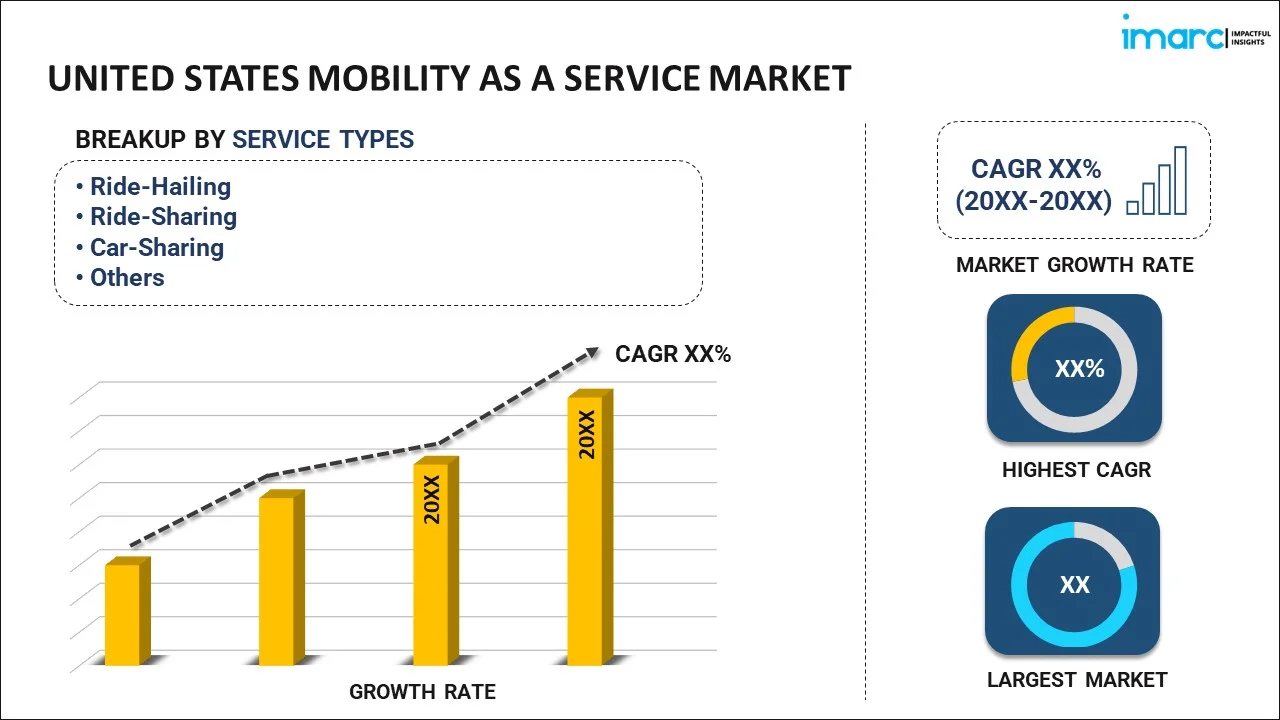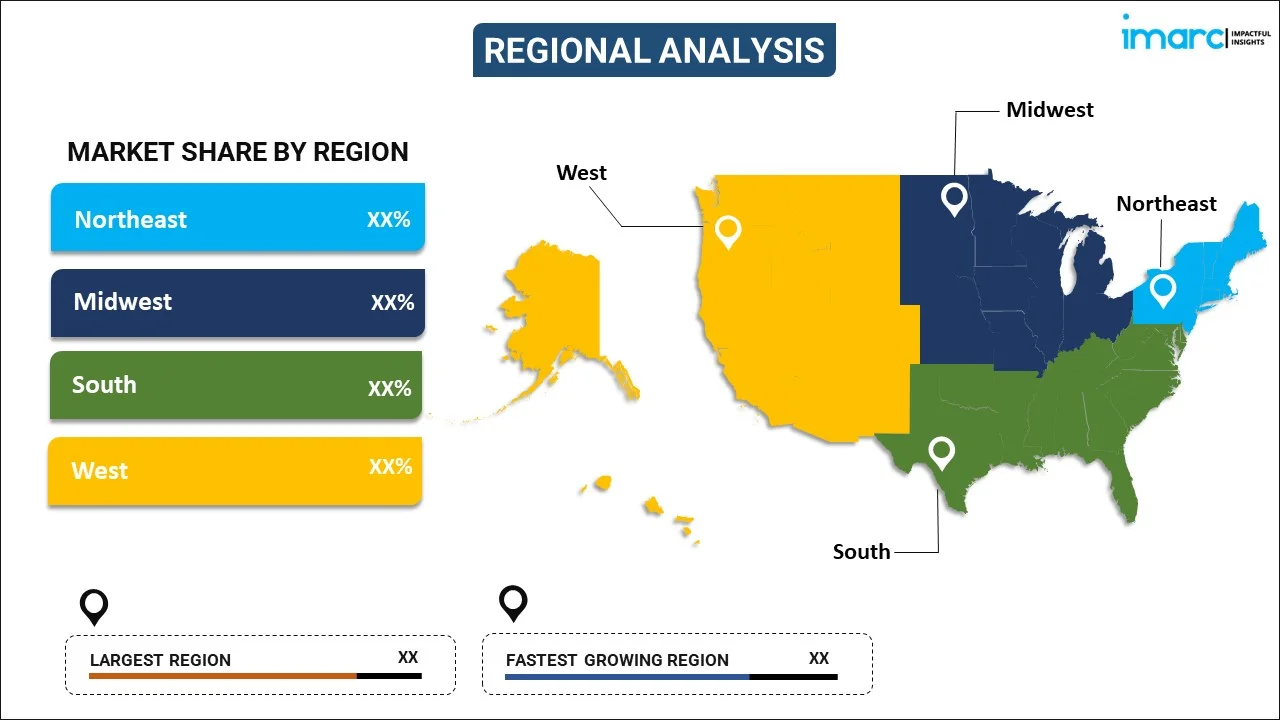
United States Mobility as a Service Market Report by Service Type (Ride-Hailing, Ride-Sharing, Car-Sharing, Bus/Shuttle Service, and Others), Transportation Type (Private, Public), Application Platform (Android, iOS, and Others), Propulsion Type (Electric Vehicle, Internal Combustion Engine, and Others), and Region 2025-2033
Market Overview:
United States mobility as a service market size reached USD 2.6 Billion in 2024. Looking forward, IMARC Group expects the market to reach USD 36.7 Billion by 2033, exhibiting a growth rate (CAGR) of 34.5% during 2025-2033. The rising concerns about traffic congestion and environmental issues that enhance the need for smarter and more sustainable transportation options, are driving the United States mobility as a service market share.
|
Report Attribute
|
Key Statistics
|
|---|---|
|
Base Year
|
2024
|
|
Forecast Years
|
2025-2033
|
|
Historical Years
|
2019-2024
|
|
Market Size in 2024
|
USD 2.6 Billion |
|
Market Forecast in 2033
|
USD 36.7 Billion |
| Market Growth Rate 2025-2033 | 34.5% |
United States Mobility as a Service Market Analysis:
- Major Drivers: Increasing traffic congestion issues and urbanization are driving demand for end-to-end mobility solutions. Environmentally conscious trends and policy support for sustainable transport options are fostering market penetration. Smartphone penetration and digital payment infrastructure are making it easier to experience multiple modes of transport seamlessly in urban segments.
- Key Market Trends: The convergence of IoT and AI technologies into transportation platforms is driving the market demand. Integration of autonomous vehicles and electric vehicles is transforming service offerings. Multi-modal trip planning and real-time optimization are becoming essential features, leading to improved overall user satisfaction and operational efficiency.
- Market Challenges: Complexity of regulatory issues and diverse local transportation policies result in implementation challenges across states. Data privacy and cybersecurity threats are major challenges for service providers. Interoperability among various transport systems and payment systems is limited, creating hindrances in seamless integration, impacting United States mobility as a service market demand.
- Market Opportunities: The industry is underpinned by collaboration among public and private transport providers. Increasing corporate mobility programs and pay-per-use schemes provide enormous revenue potential. Smart city initiatives and renewable energies integration provides opportunities for development of sustainable transportation ecosystems.
Mobility as a service (MaaS) is a paradigm shift in transportation, integrating various modes like public transit, ride-sharing, biking, and more into a unified, user-centric platform. It aims to simplify and enhance the travel experience by providing a one-stop solution for planning, booking, and paying for diverse transportation services. Users can access real-time information, plan multi-modal journeys, and seamlessly transition between modes, promoting efficiency and sustainability. MaaS leverages digital technology, data analytics, and smart infrastructure to optimize routes, reduce congestion, and minimize environmental impact. By prioritizing the user's needs and offering a holistic approach to mobility, MaaS envisions a future where transportation is not just a means of getting from point A to B but a personalized, interconnected, and sustainable ecosystem that enhances urban living.
United States Mobility as a Service Market Trends:
Integration of Artificial Intelligence and Machine Learning
The application of ML and AI technologies is transforming the United States mobility as a service market growth by allowing for predictive analytics, optimal routing, and customized user experience. These technologies allow for real-time traffic analysis, demand forecasting, and dynamic pricing models that increase operational efficiency. AI-based platforms are able to forecast user preferences, recommend travel routes, and automatically make adjustments from past data and actual conditions. Machine learning software constantly enhances service quality by constantly monitoring user behavior patterns, lowering waiting times, and streamlining fleet operations. Voice assistants and chatbots integration offers improved customer support, while predictive maintenance minimizes vehicle downtime. Such technological innovation is even more important in large metropolitan cities where intricate transportation systems demand advanced coordination. The shift toward smart mobility solutions will lead to significant investment in AI infrastructure and collaborations between transport service providers and technology firms.
Electric and Autonomous Vehicle Integration
The shift to electric and autonomous cars is a foundational change in the mobility ecosystem, having profound effects on United States mobility as a service market analysis. Electric vehicle utilization in MaaS platforms is gaining speed based on environmental policy, cost benefits, and enhanced charging infrastructure. Pilot programs for autonomous vehicles are being initiated across states, with businesses piloting self-driving rideshare operations and last-mile delivery solutions. Such integration lowers the cost of operations by cutting down on driver costs while possibly enhancing safety through sophisticated sensor technology and autonomous driving systems. The marriage of electric and autonomous technologies gives rise to new service offerings such as autonomous electric shuttles for urban and campus transportation. Incentives from the government on clean transportation technology are promoting this shift, with collaborations between auto manufacturers and MaaS providers growing fast. The coming together of such technologies is likely to radically reconfigure urban mobility, lower emissions, and make transportation networks more efficient in American cities.
Subscription-Based and Corporate Mobility Programs
The rise of subscription mobility services and company programs is fueling new revenues and increasing market expansion in the market forecast. Firms are increasingly providing workers with full mobility benefits as substitutes for traditional car allowances, such as access to a variety of transportation modes via a single platform. Subscription platforms offer customers the benefit of having regular monthly bills while accessing multiple transportation modes, ranging from ride-sharing to bike-sharing and mass transit. Corporate partnerships provide bulk purchasing capability, lower per-trip expenses, and higher employee satisfaction with convenient mobility solutions. Expense management tools, reporting capabilities, and integration with current corporate systems are often included in these programs. Universities and large enterprises are rolling out campus-wide mobility programs that lower parking demand while enhancing accessibility. Mobility-as-a-benefit is especially prevalent in major cities where parking fees are high and environmental issues are a priority. This transition is a paradigm shift in the nature of how organizations provide employee transportation, opening up vast opportunities for MaaS providers to increase their customer base and revenue streams.
United States Mobility as a Service Market Segmentation:
IMARC Group provides an analysis of the key trends in each segment of the market, along with forecasts at the country levels for 2025-2033. Our report has categorized the market based on service type, transportation type, application platform, and propulsion type.
Service Type Insights:

To get more information on this market, Request Sample
- Ride-Hailing
- Ride-Sharing
- Car-Sharing
- Bus/Shuttle Service
- Others
The report has provided a detailed breakup and analysis of the market based on the service type. This includes ride-hailing, ride-sharing, car-sharing, bus/shuttle service, and others.
Transportation Type Insights:
- Private
- Public
A detailed breakup and analysis of the market based on the transportation type have also been provided in the report. This includes private and public.
Application Platform Insights:
- Android
- iOS
- Others
The report has provided a detailed breakup and analysis of the market based on the application platform. This includes android, iOS, and others.
Propulsion Type Insights:
- Electric Vehicle
- Internal Combustion Engine
- Others
A detailed breakup and analysis of the market based on the propulsion type have also been provided in the report. This includes electric vehicle, internal combustion engine, and others.
Regional Insights:

- Northeast
- Midwest
- South
- West
The report has also provided a comprehensive analysis of all the major regional markets, which include Northeast, Midwest, South, and West.
Competitive Landscape:
The market research report has also provided a comprehensive analysis of the competitive landscape. Competitive analysis such as market structure, key player positioning, top winning strategies, competitive dashboard, and company evaluation quadrant has been covered in the report. Also, detailed profiles of all major companies have been provided.
Recent News and Development:
- In September 2025, Hyundai Motor Group launched the Next Urban Mobility Alliance (NUMA), a public-private initiative to advance inclusive smart city mobility using AI and autonomous technologies. NUMA fosters collaboration among government, industry, and academia to transform urban transportation, especially for communities with limited access. The alliance will develop AI-powered local transport, Autonomous Mobility-as-a-Service, and smart city solutions, showcasing prototypes like universal design vehicles to improve mobility for all, while promoting cross-sector innovation and policy alignment.
- In July 2025, Lyft is partnering with BENTELER Mobility to launch autonomous shuttles on its U.S. platform in 2026, focusing on airports and city centers. Developed by HOLON GmbH, the shuttles use Mobileye’s autonomous driving technology and are purpose-built for shared, short-distance urban travel. A new $100 million production facility in Jacksonville, Florida, will support initial deployment. The initiative aims to accelerate AV adoption, combining Lyft’s ride-hailing network with BENTELER’s manufacturing and fleet capabilities.
United States Mobility as a Service Market Report Coverage:
| Report Features | Details |
|---|---|
| Base Year of the Analysis | 2024 |
| Historical Period | 2019-2024 |
| Forecast Period | 2025-2033 |
| Units | Billion USD |
| Scope of the Report | Exploration of Historical and Forecast Trends, Industry Catalysts and Challenges, Segment-Wise Historical and Predictive Market Assessment:
|
| Service Types Covered | Ride-Hailing, Ride-Sharing, Car-Sharing, Bus/Shuttle Service, Others |
| Transportation Types Covered | Private, Public |
| Application Platforms Covered | Android, iOS, Others |
| Propulsion Types Covered | Electric Vehicle, Internal Combustion Engine, Others |
| Regions Covered | Northeast, Midwest, South, West |
| Customization Scope | 10% Free Customization |
| Post-Sale Analyst Support | 10-12 Weeks |
| Delivery Format | PDF and Excel through Email (We can also provide the editable version of the report in PPT/Word format on special request) |
Key Benefits for Stakeholders:
- IMARC’s industry report offers a comprehensive quantitative analysis of various market segments, historical and current market trends, market forecasts, and dynamics of the United States mobility as a service market from 2019-2033.
- The research report provides the latest information on the market drivers, challenges, and opportunities in the United States mobility as a service market.
- Porter's five forces analysis assist stakeholders in assessing the impact of new entrants, competitive rivalry, supplier power, buyer power, and the threat of substitution. It helps stakeholders to analyze the level of competition within the United States mobility as a service industry and its attractiveness.
- Competitive landscape allows stakeholders to understand their competitive environment and provides an insight into the current positions of key players in the market.
Key Questions Answered in This Report
The mobility as a service market in the United States was valued at USD 2.6 Billion in 2024.
The United States mobility as a service market is projected to exhibit a CAGR of 34.5% during 2025-2033, reaching a value of USD 36.7 Billion by 2033.
The market is driven by rising concerns about traffic congestion and environmental issues, increasing urbanization necessitating innovative transportation solutions, growing smartphone penetration facilitating platform accessibility, escalating costs of private vehicle ownership prompting alternative mobility exploration, and growing environmental consciousness fueling demand for sustainable transportation alternatives.
Need more help?
- Speak to our experienced analysts for insights on the current market scenarios.
- Include additional segments and countries to customize the report as per your requirement.
- Gain an unparalleled competitive advantage in your domain by understanding how to utilize the report and positively impacting your operations and revenue.
- For further assistance, please connect with our analysts.
 Request Customization
Request Customization
 Speak to an Analyst
Speak to an Analyst
 Request Brochure
Request Brochure
 Inquire Before Buying
Inquire Before Buying




.webp)




.webp)












